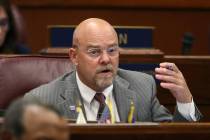Nevada transportation department wishes for bliss on Las Vegas freeways

Call me paranoid, but when the Nevada Department of Transportation (motto: “Slow and Steady Wins the Race!”) starts talking about reducing congestion, I get suspicious.
But only because — as a regular user of Las Vegas freeways, unlike, say, the brass of NDOT — I’ve seen precious little evidence that the department is interested in fast-moving traffic.
These are, after all, the folks who brought you the Most Counterintuitive Freeway Interchange Ever: If you want to exit northbound Interstate 15 to U.S. 95 to go to Summerlin (which lies to your left) you must bear all the way right. If you want to get to downtown (on your right) you have to bear (slightly) left.
The latest counterintuitive suggestion from our friends at NDOT is known in traffic-engineering circles as the “zipper merge.” And getting caught in one of those can be painful!
Instead of merging as soon as you see an upcoming lane closure, NDOT wants you to keep going, right up to the cones and flashing signs — and then merge. Cars from the still-open lane and the closed lane will co-operate and take turns, like teeth in a closing zipper fitting together.
At least, that’s how it works in theory.
But in theory, people are basically good. But one day on Las Vegas freeways will cure that delusion. If Gandhi spent a week driving in Las Vegas, he’d turn into Hannibal Lecter.
Here’s how the “zipper merge” will actually work: Cars cutting in to the open lane at the last second will cause vehicles in the still-open lane to brake, which will spark a chain reaction that will ultimately bring that lane to a tire-screeching halt. Drivers who spotted the closed lane miles back and got into the working lane early will see others zipping by in the closed lane and assume they’re trying to beat the system, and won’t let them merge when the time comes, which will cause the closed lane to back up. And that’s not to mention the sociopathic bastards using the shoulder to bypass all the lanes, who then have to merge back into traffic, causing even more braking.
Ladies and gentlemen, meet gridlock.
To be fair, it’s not just NDOT that embraces zipper merging. A story in the Wall Street Journal in January reported, “There’s a growing consensus among state transportation officials that when a lane closure is looming, getting drivers to use all available lanes until the point where cars need to merge can keep traffic moving more efficiently and safely, and even cut down on road rage.”
But Minnesota transportation department spokesman T.J. Melcher admitted to the Journal that in a friendly state like his, cutting in line isn’t seen as cool. “It’s kind of counterintuitive,” he said of the zipper merge. “We defer to others a lot in our culture here.”
Here in Las Vegas, by contrast, we’ll run a bus full of nuns off the road if it will save 30 seconds on our morning commute.
In California, where they know a thing or two about traffic, construction and congestion, they’re a little more realistic: “When drivers wait until that last minute, it can lead to sudden braking and cause rear-end collisions,” Caltrans spokesman Mark Dinger told the Journal.
Not to mention raised fingers, shouted curses or, in severe cases, roadside fisticuffs or shots fired.
Hesham Rakha, a Virginia Tech professor of civil and environmental engineering, put it best in a separate Journal story about the causes of congestion: “Everyone is selfish and wants maximal travel time versus optimal time for everyone,” he said. “By being selfish, you make the system worse.”
But wishing people were more kindhearted isn’t a traffic-planning strategy. It’s a recipe for roadway disappointment.
Steve Sebelius is a Review-Journal political columnist. Follow him on Twitter (@SteveSebelius) or reach him at 702-387-5276 or SSebelius@reviewjournal.com.












